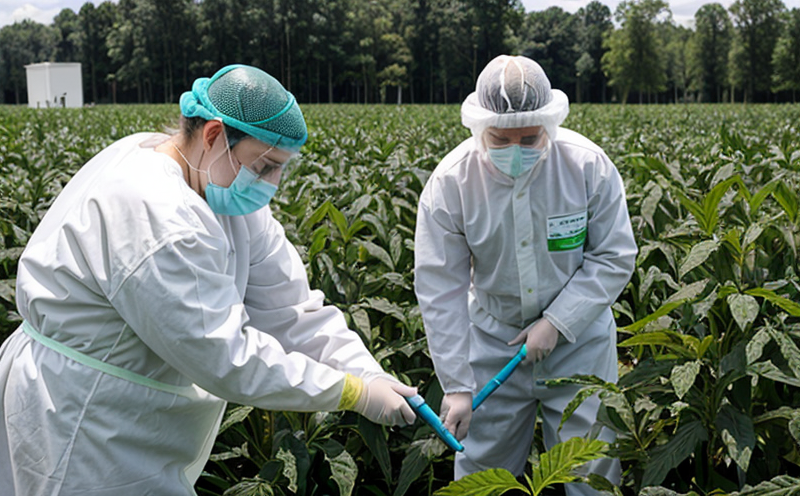USDA Biocontrol Microorganism Safety Testing
The USDA Biocontrol Microorganism Safety Testing is a critical component in the development and certification of beneficial microorganisms used as biocontrol agents. This service ensures that these organisms are safe for both the environment and human health, thereby facilitating sustainable agricultural practices while reducing reliance on chemical pesticides.
Biological control relies on naturally occurring microorganisms to manage pests or diseases without causing harm to non-target species or the ecosystem. The USDA Biocontrol Microorganism Safety Testing focuses primarily on ensuring that these microorganisms are not pathogenic and do not pose a risk during their intended use. This service is essential for companies developing biopesticides, microbial inoculants, and other beneficial microorganisms.
The testing process involves several stages to ensure comprehensive safety evaluation. The first stage includes the identification of the microorganism using advanced molecular techniques such as DNA sequencing and serotyping. This ensures that the organism being tested is accurately identified before proceeding with further evaluations.
Once the identity is confirmed, the next step involves assessing the potential for pathogenicity through in vitro and in vivo testing. In vitro tests are conducted on human or animal cells to determine whether the microorganism can cause disease in a controlled environment. These tests help identify any potential risks early in the development process.
In vivo tests involve exposing non-target organisms such as beneficial insects, plants, or soil microbes to the biocontrol agent under controlled conditions. This helps assess the impact of the organism on the broader ecosystem and ensures that it does not disrupt existing ecological balances.
The testing also includes evaluating the stability and efficacy of the microorganism over time and across different environmental conditions. This ensures that the biocontrol agent remains effective throughout its intended use, maintaining its role in pest management without adverse effects.
Compliance with international standards is crucial for this service. The USDA follows guidelines from ISO 21684:2019 and ASTM E3752-2015 to ensure that the testing process meets global benchmarks. These standards provide a framework for conducting robust safety assessments, ensuring consistency and reliability in test results.
For quality managers and compliance officers, this service offers peace of mind by providing rigorous evidence that biocontrol agents meet regulatory requirements. R&D engineers benefit from detailed insights into the behavior and potential impacts of new microorganisms, aiding in product development and optimization. Procurement professionals can ensure that they are sourcing safe and effective biopesticides from trusted suppliers.
The USDA Biocontrol Microorganism Safety Testing is a cornerstone of sustainable agriculture practices. By ensuring that biocontrol agents are safe for both the environment and human health, this service supports the transition to more environmentally friendly pest management strategies. This not only enhances agricultural productivity but also contributes to global efforts towards sustainability.
Why Choose This Test
- Makes biocontrol agents safer for use in agriculture.
- Avoids potential risks to human health and non-target species.
- Ensures compliance with international standards.
- Promotes sustainable agricultural practices by reducing chemical pesticide use.
- Provides detailed insights into the behavior and impacts of biocontrol agents under various conditions.
- Supports product development and optimization for R&D engineers.
- Ensures that biopesticides and microbial inoculants meet regulatory requirements, facilitating market entry.
- Promotes biodiversity by minimizing disruption to existing ecological balances.
International Acceptance and Recognition
The USDA Biocontrol Microorganism Safety Testing is widely recognized and accepted globally. Regulatory bodies in various countries rely on the results of this testing for approvals, making it a critical step in bringing biopesticides to market.
Countries such as the United States, Canada, and several European nations have integrated these testing standards into their regulatory frameworks. This recognition ensures that companies can confidently use the USDA Biocontrol Microorganism Safety Testing to meet international requirements.
Environmental and Sustainability Contributions
The USDA Biocontrol Microorganism Safety Testing plays a vital role in promoting environmental sustainability by ensuring that biopesticides are safe for non-target species. This reduces the risk of unintended harm to beneficial insects, plants, and soil microbes.
By supporting sustainable agricultural practices, this service helps reduce the environmental footprint associated with chemical pesticides. It contributes to biodiversity conservation and promotes healthier ecosystems, which is crucial in addressing global sustainability challenges.





